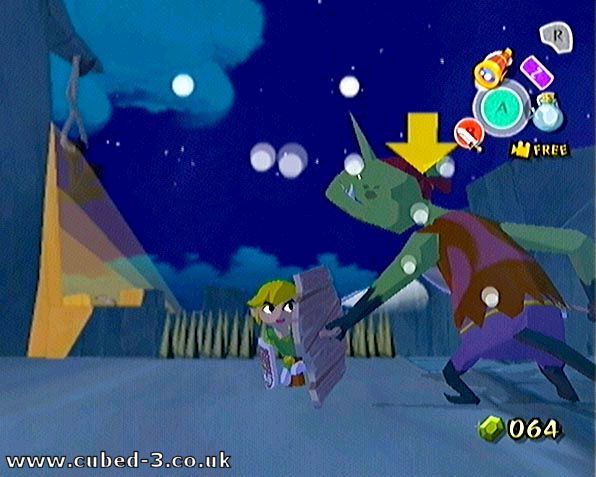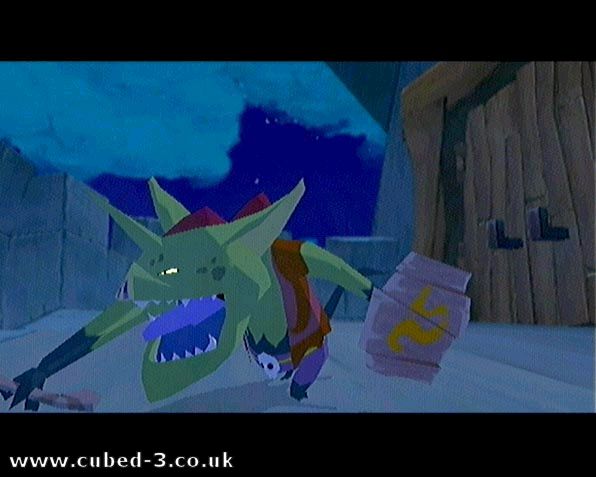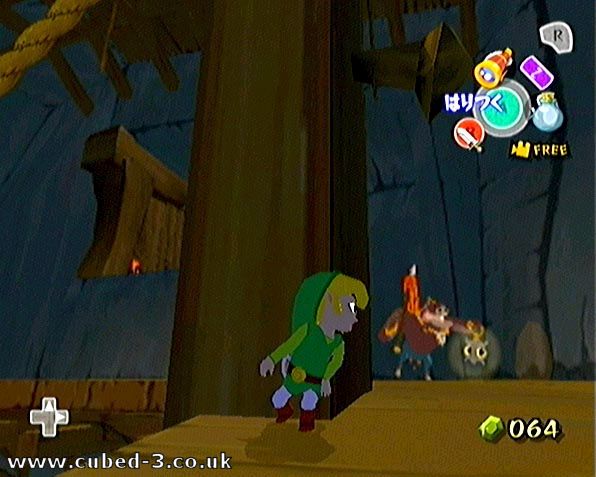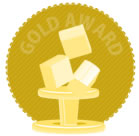The Legend of Zelda: The Wind Waker (GameCube) Review
By Jorge Ba-oh  30.06.2003
30.06.2003

The Legend of Zelda: The Wind Waker -- the game that has stirred some controversy in the gaming cauldron and one that many consider to be the first true sequel to Ocarina of Time, Link returns with perhaps a look that many had not expected the franchise to evolve into with a new console. The legend returns in a new form, some may consider it a somewhat different portrayal of our hero's emotions, an innovative look at the world of Hyrule. The main difference that preceded this version was the initial look for the sequel – manic muscular tones, brute force and smooth animation, but, perhaps in many eyes, it was a cheap sequel to put it bluntly. Upon this, Nintendo decided to introduce a new array of visuals to Link’s ensemble, now he had become enriched with cell shaded prowess, ready to face darkness like the legend before him.
Trying to perhaps relate back to the SNES classic, A Link to the Past, Nintendo have placed link amongst some family relatives, and perhaps wanted to reveal a greater depth to the introduction of the adventure. Starting rather low key, it seems that nothing was wrong on the small island of Outset that our hero inhabited, the composed waves smoothly crawling up shore and the slight staccato of a familiar tune beating into your ears. It’s Link’s birthday, and for his eagerly awaited present, his grandmother provides him with the stereotypical green tunic that we’ve all grown to love, and after which sends him off to meet his rather excited sibling up on the watchtower. Still there is quite an enigmatic breeze around the area, something doesn’t seem right… His sister provides him with a small telescope, something quite innovative in Nintendo’s light, and so the story begins – with an exhilarating entrance, a deranged bird swoops down from above, and seems to have a female pirate within its firm grasp, but, he loyal crew manage to distorted the bird off course and she falls into the woods at the pinnacle of the island. Saved by Link and heading back to the island, they notice that the creature this time has set its eyes on his sister… Now having lost his only sibling, our hero sets sail to find her and solve the obscurity of the giant creature and it’s urges for “pointed eared” girls.
Well, I had to write about it in a review, and will put it bluntly… The graphics, from what is there, are immense. Pure Nintendo quality, but in perhaps a slightly different way from what we had expected with news of it’s release on the GameCube. Many gamers who have stuck with the Zelda franchise have been opposed to the cell-shaded version, but Nintendo have used it to full effect and perhaps diminished initial controversial views on it. Unlike the previous 3D Zelda titles, the graphics aren’t present to provide a “wow” factor, or to capture people’s interests, but, it is present to be functional, it’s there to be used and not just be part of the background like some of his past adventures. You an actually feel like you’re part of the game, now, from the screenshots and videos, perhaps not, but with some exploration, it would do nicely. It may not be to the same scale as visual masterpiece, Metroid Prime or even titles on other consoles, but it has its own unique style and finesse that it shouldn’t be compared to, well, any other title. The animation matches the brilliance of the artistic style of the graphics. The simulation of the timid marching of the amateur Moblin soldiers to the soaring bosses trying effortlessly to crush the young hero are impeccable and are extremely fluid, and perhaps are executed with very little in terms of glitches. The use of lighting is another minor thing, but it is utilised very well, especially when the game perils into darkness at certain points, of the luminous sunshine periling over Link’s face, but also the very small attention to detail can be noted. When returning to land after a peaceful swim, or the desperate return for something to put your feet on, small water particles will elaborately drop off your tunic onto the ground, prints will be inputted into the sand on which you walk upon. It’s these miniscule touches that perhaps add a little bit of realism into a game designed to counteract that. On the whole, I did find it odd why the sea is a huge plat of blue with the immensely tiny waves, but it seems the developers perhaps wanted to add a swimming limit and also reminisce with the classic water/swimming found in the Snes version. In terms of what the engine was truly designed to do – portray emotions, it pulls this off well. Before you’ve played the title, you’ve probably heard of importers, magazines and even sites boast their findings on the environmental bliss – Link’s facial expressions, the sudden changes in the areas you’re in… priceless. This all amounts to a graphical engine that you haven’t really experienced before, and until you do, will find it hard to really grasp it’s contrast between that and previous expectations. But, on a related note, it’s hard to imagine the game, in that respect being realistic, although it seems that in places you really do feel like there is something missing, perhaps some areas are lacking in terms of detail, and aren’t really as clean as they could have been.

Overall, the graphics are utilised to their full effect, and perhaps could have been refined in places, it seems that although it’s got style and charisma from the developing body, there is a sense of wanting some realism, and the small effects I noted above do just that. But, the game’s graphics perform in the ways in which the developers had intended – fluid and vibrant, a contrast to the classic game of age, but shouldn’t really be compared as it’s style is unique in its own right.
The game’s unique style follows on from the graphics. The ever so small voice samples used by the various characters throughout the game reflects to its subtle touches. It seems that if Nintendo had opted to use voices, dub and add in a full amount of speech, it would perhaps be delayed due to localisation of the speech and also some fans may not agree with what would most likely be a corny representation of Link’s personality. See Starfox. When coupled with the text and facial expressions of characters, the effect is excellent, perhaps even hilarious in places – all providing some bit of life into the game, rather than stale lifeless motion. With the musical compositions, this is perhaps essentially a remixed version of the Ocarina of Time with a first listen, but, the cleverly combines samples from previous titles, but perhaps there isn’t enough variation in new music to create the feeling of a new adventure, although it can be a worthy remix for nostalgic lovers. The additional usage of music to reflect upon what is happening in your surroundings is a unique touch, as well as certain elements and periods of time adding the sense of ambiance, but only as a subtle addition. My own true criticism is at this day and age at where technology stands, why the developers didn’t decide to perhaps introduce real orchestrated music into the title in which it is needed or desired. Although, I am pleased they decided to include some of the best pieces from beyond Ocarina, some from the Snes and others from the different sequels, all of which aid the environment you’re in and add the extra sense of atmosphere.

Get this, it's a Zelda game from Nintendo, this is where the game probably excels the most, but, as I mentioned above, controversy has subdued this game’s mechanics into a very unbalanced argument. As a whole, the gameplay is very close to that found on the Nintendo64’s Ocarina of Time, it’s similar in the control aspect – with a familiar button layout and combat being, in my view, a little refined in his GameCube outing, although there has been discussion regarding the ease of beating enemies, namely bosses. In a strange twist, the developers have destroyed the once field based lands of Hyrule and with this, dwelled the land into a watery grave for to travel around, you require the use of a small and rather strange enigmatic boat. But, to actually navigate across the spiralling lands, you need to make use of the wind, no, the title isn’t just there for pure coincidence and the clever usage of the wind is nothing but breathtaking, no pun intended.
Every pace you make will be useful, each location is as compelling as the next and is a useful comparison to past titles, although there are familiar surroundings that the developers have employed, all of which reflect upon nature – wind, fire, etc, and it’s this clever sequence of locations that perhaps holds the game together somewhat. Because of the sheer size of the ocean, the overworld has the epic sense of space but the lack of a plethora of enemies to irradiate in places, perhaps adds to the beauty of each location, or even could build up a dramatic sense of tension, but, it seems that the planning of where and when enemies sprawl forth isn’t as solid as the SNES classic. The transition to each location you had to visit is excellent at first, for the first time in a Zelda game; you are able to navigate around the seas of Hyrule, well, it’s the first of any title with such an ability, but, the length between islands can become a little tedious. Thankfully, Nintendo have included a little extra to relive you of sailing, but, you have to discover it first… Although the regions are expansive, the smaller areas do in fact have a lot of depth. From the small postal shop in one island, to the jewellers on another, this infatuation with reality becomes prominent as the game continues. But, it seems that an ageing developer’s dreams of immersing himself with fields and caves has been vanquished, although the game still supports itself by providing a somewhat unique experience and still making reference to strengths of the old.
Dungeons, dungeons – something that someone with past Zelda experience will definitely make reference to, and notably this is another debatable issue being a sequel to Ocarina of Time. To me, they are expansive in one sense, but can be a little toward the easy side to be a true challenge in evaluation, but they are perhaps a little better thought out than the Nintendo 64 prequel and the use of “teleporting pots” are a valid addition. Although the gameplay stems from the exploration and story development, it seems that due to the clever use of plot and narrative in this version, the dungeons can really be judged as a location rather than a massive venture. It’s a shame that they couldn’t have been a little more demanding to gamers with some experience, although they do have some very innovative additions in places.

Perhaps something to just touch upon is the environment, no, not ours, but the ones within the world of Zelda. In the past, in my view, it was too realistic to be of any use. As a gamer that loves exploration I felt that Ocarina seemed to have you essentially walking on a picture, with many elements being there without having any significant purpose or couldn’t be used. However, in the Wind Waker, there are many things you can deform, destroy and use, with there very smallest of unique touches that perhaps enhances the charisma of the title, without being overly obvious. For example, in the first location you arrive at, there are their ickle cups and saucers, gently walk into them, they rattle, add a little pressure and they decapitate. It’s this ever so small addition that conceivably augments the gameplay somewhat.
The wind factor is perhaps the only major difference in the game’s mechanisms you will notice if in comparison to the N64 “legend”. There are a few new weapons, or more like remixed/improved ones, but are nevertheless useful in the vastly superior combat found in the Wind Waker, but the whole experience feels similar. The rather sublime control mechanism from the N64 games is recreated and fine-tuned to perfection. Those who have played the previous games will notably agree on the easier combat on the Game cube, and the additional “free camera” roaming system is a wise addition. Everything from Link’s smooth actions to the sheer expansion of the game is evidence enough to show that suitable development has gone into this title.
On the other hand, not enough development perhaps had gone into the game, some dungeons had been emitted, places reduced and perhaps a few minor collisions not functioning as smoothly as they should have. Also, the game’s beginning, whilst a little low key has a very sharp contrast that, in my view, hinders the learning or exploration progress that Ocarina of Time had, and it’s this sudden action sequence that could put off new gamers entering the franchise.
Overall, it’s good for what is there. Notably, there are direct contrasts you can make with the Ocarina of time, but whilst one game has what the other may not, it seems that the classic formula has indeed been replicated in this game, there are elements missing, but it’s good for what’s presented and could be taken further in a sequel.

Cubed3 Rating
Exceptional - Gold Award

It is a close call between this adventure and Ocarina of Time. Both titles are respectable in their own right, and The Wind Waker, although a little short and easy in places, it's different in that own respect and should be considered, and is, a top Nintendo title, and perhaps this could lead to something even more special.

![]() 9/10
9/10
![]() 10/10
(42 Votes)
10/10
(42 Votes)
 Out now
Out now  Out now
Out now  Out now
Out now  Out now
Out now Comments
Comments are currently disabled

 Sign In
Sign In Game Details
Game Details Subscribe to this topic
Subscribe to this topic Features
Features






 Top
Top

